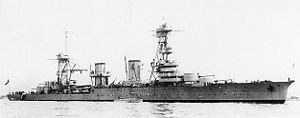Soviet cruiser Krasnyi Kavkaz
 |
|
| History | |
|---|---|
|
|
|
| Name: | Krasnyi Kavkaz |
| Builder: | Russud Dockyard, Nikolayev |
| Laid down: | 31 October 1913 |
| Launched: | 21 June 1916 |
| Acquired: | November 1917 |
| Commissioned: | 25 January 1932 |
| Renamed: | 14 December 1926 from Admiral Lazarev |
| Reclassified: | 12 May 1947 as a training ship |
| Honours and awards: |
awarded the Guards title on 3 April 1942 |
| Fate: | Sunk as target 21 November 1952 |
| General characteristics (in 1940) | |
| Class and type: | Admiral Nakhimov-class cruiser |
| Displacement: |
|
| Length: | 159.5 m (523 ft 4 in) |
| Beam: | 15.7 m (51 ft 6 in) |
| Draught: | 6.6 m (21 ft 8 in) |
| Propulsion: |
|
| Speed: | 29 knots (33 mph; 54 km/h) |
| Range: | 3,500 nmi (6,480 km) at 15 knots (28 km/h) |
| Complement: | 878 |
| Armament: |
|
| Armour: |
|
| Aircraft carried: | 2 × KOR-1 seaplanes |
| Aviation facilities: | 1 catapult |
Krasnyi Kavkaz (from Russian: "Красный Кавказ" - "Red Caucasus") was a cruiser of the Soviet Navy that began construction during World War I, but was still incomplete during the Russian Revolution. Her design was heavily modified by the Soviets and she was completed in 1932. During World War II she supported Soviet troops during the Siege of Odessa, Siege of Sevastopol, and the Kerch-Feodosiya Operation in the winter of 1941—42. She was awarded the Guards title on 3 April 1942. She was reclassified as a training ship in May 1947 before being expended as a target in 1952.
Laid down on 18 October 1913 at the Rossud Dockyard as Admiral Lazarev for the Imperial Russian Navy as a cruiser of the Svetlana class, she was launched on 8 June 1916. Construction was abandoned in 1917 during the October Revolution when the ship was 63% complete. In the second half of 1918, the Marine Department of Hetman Pavlo Skoropadskyi was engaged in completion of ship. On 25 January 1919, the ship was formally renamed in "Hetman Petro Doroshenko", but Mykolaiv was captured shortly afterward by the Entente. The hull was relatively undamaged and the Soviets decided to finish the ship to a modified design. She was renamed Krasnyi Kavkaz on 14 December 1926, and completed to a modernized design, being commissioned on 25 January 1932.
Krasnyi Kavkaz was initially intended to accommodate eight 8-inch (200 mm) guns in four twin turrets, but this was impossible given her small and lightly constructed hull. Three twin turrets mounting the new 57-caliber 180 mm (7.1 in) B-1-K gun under development also proved impracticable and the Soviets had to settle for four MK-1-180 single 180 mm gun turrets, two at each end. Her superstructure was massively revised to fit these turrets and all of the original casemated 130-millimeter (5.1 in)/55 B7 Pattern 1913 guns were removed. As completed her secondary armament was only four 30-caliber 76.2 mm Lender AA guns mounted between her funnels. Her original internal torpedo tubes were replaced by four triple 533-millimetre (21.0 in) torpedo mounts mounted on each side of the main deck abaft the forecastle break. She was given an aircraft-handling crane, but a catapult wasn't installed aft of her rear funnel until 1935 when a Heinkel catapult was imported from Germany. She was also fitted for mine rails with a capacity of up to 120 mines.
...
Wikipedia
